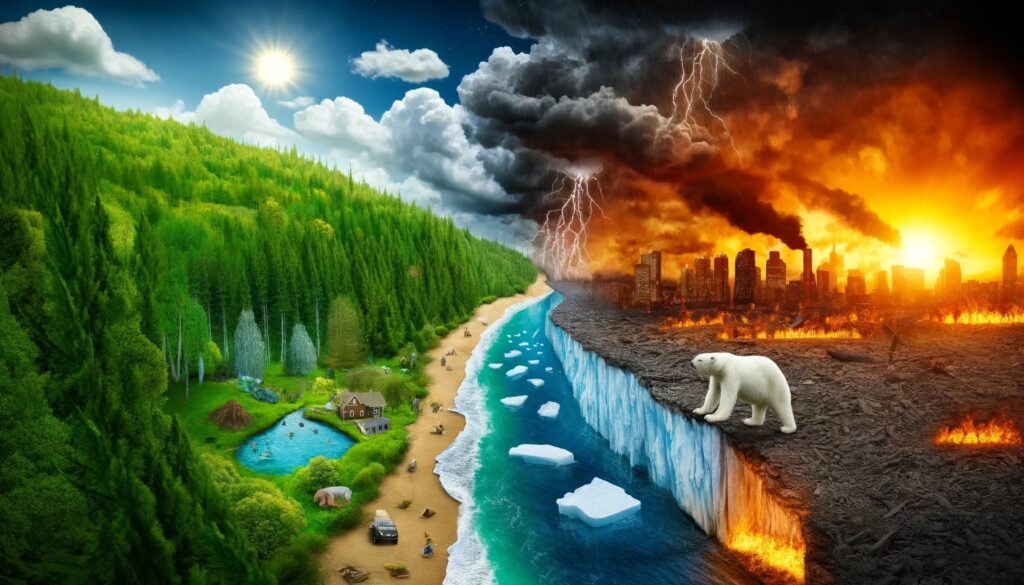Global warming is one of the most pressing issues of our time, and its impacts are being felt across the world. As greenhouse gas emissions continue to rise, the planet’s climate is undergoing significant changes, leading to a myriad of environmental, economic, and social challenges. Understanding the factors contributing to global warming and its far-reaching effects is crucial for developing effective strategies to combat this global crisis.

Factors Contributing to Global Warming
- Greenhouse Gas Emissions:
The primary driver of global warming is the increase in greenhouse gases (GHGs) in the atmosphere. Carbon dioxide (CO2), methane (CH4), nitrous oxide (N2O), and fluorinated gases trap heat and prevent it from escaping into space. The burning of fossil fuels for energy, deforestation, industrial activities, and agricultural practices are major sources of these emissions. - Deforestation and Land Use Changes:
Forests act as carbon sinks, absorbing CO2 from the atmosphere. However, deforestation for agriculture, logging, and urban development reduces the number of trees available to sequester carbon, increasing the concentration of CO2 in the atmosphere. Additionally, land use changes often release stored carbon from soils and vegetation. - Industrial Activities:
The industrial sector is a significant contributor to GHG emissions. Manufacturing processes, chemical production, and cement production release large amounts of CO2 and other pollutants. Industrialization, especially in developing countries, has accelerated emissions. - Agriculture:
Agricultural practices contribute to global warming through the release of methane from livestock and rice paddies, nitrous oxide from fertilized soils, and CO2 from deforestation for agricultural expansion. The use of synthetic fertilizers and pesticides also releases potent greenhouse gases. - Energy Production:
Fossil fuel combustion for electricity and heat production is the largest single source of global CO2 emissions. Coal, oil, and natural gas are the primary energy sources, and their burning releases substantial amounts of CO2. The energy sector’s reliance on these fuels makes it a critical area for emission reduction efforts.
Impacts of Global Warming
- Rising Temperatures:
Global temperatures have been steadily rising, leading to more frequent and severe heatwaves. Higher temperatures impact ecosystems, agriculture, and human health, increasing the risk of heat-related illnesses and reducing crop yields. - Melting Ice and Rising Sea Levels:
Warming temperatures are causing polar ice caps and glaciers to melt, contributing to rising sea levels. Coastal communities are facing increased risks of flooding, erosion, and saltwater intrusion, threatening livelihoods and habitats. - Extreme Weather Events:
Climate change is linked to an increase in the frequency and intensity of extreme weather events such as hurricanes, typhoons, droughts, and heavy rainfall. These events cause widespread damage to infrastructure, agriculture, and ecosystems, leading to economic losses and displacement of people. - Ocean Acidification:
The oceans absorb a significant portion of CO2 emissions, leading to increased acidity. Ocean acidification affects marine life, particularly organisms with calcium carbonate shells and skeletons, such as corals, mollusks, and some plankton species. This disrupts marine ecosystems and the food webs they support. - Biodiversity Loss:
Climate change alters habitats and disrupts ecosystems, leading to shifts in species distributions and the timing of biological events. Many species are unable to adapt quickly enough to these changes, resulting in biodiversity loss and the decline of ecosystem services.
Addressing the Challenge
- Transition to Renewable Energy:
Shifting from fossil fuels to renewable energy sources like solar, wind, and hydropower is essential to reducing GHG emissions. Investing in renewable energy infrastructure and technologies can help mitigate climate change while providing sustainable energy solutions. - Enhancing Energy Efficiency:
Improving energy efficiency in buildings, transportation, and industries can significantly reduce emissions. Adopting energy-efficient practices and technologies can lower energy consumption and decrease reliance on fossil fuels. - Protecting and Restoring Forests:
Protecting existing forests and restoring degraded lands can enhance carbon sequestration. Reforestation and afforestation efforts, along with sustainable land management practices, can help mitigate the impacts of deforestation. - Sustainable Agriculture:
Implementing sustainable agricultural practices, such as crop rotation, organic farming, and reduced use of synthetic fertilizers, can lower GHG emissions. Enhancing soil health and using agroforestry techniques can also improve carbon sequestration. - International Cooperation:
Global warming is a transboundary issue that requires international cooperation. Countries must work together to set ambitious emission reduction targets, share technologies and best practices, and provide financial support to developing nations to help them transition to low-carbon economies.
Conclusion
The increasing tensions of global warming present a formidable challenge that requires immediate and concerted action. By understanding the factors contributing to climate change and its impacts, we can develop comprehensive strategies to mitigate its effects and adapt to the changing environment. Embracing renewable energy, enhancing energy efficiency, protecting natural ecosystems, and fostering international cooperation are essential steps toward a sustainable and resilient future. The time to act is now, for the sake of our planet and future generations.
